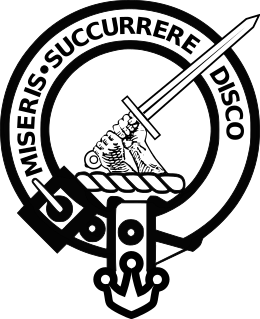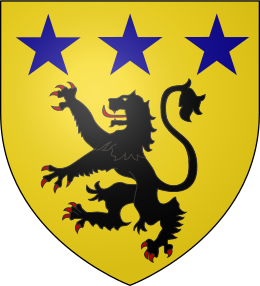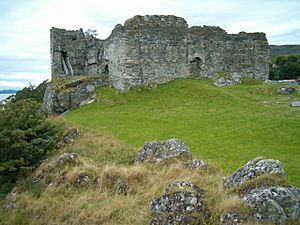Clan MacMillan facts for kids
Quick facts for kids Clan MacMillan |
|||
|---|---|---|---|
| Clann Mac GhilleMhaolain | |||
 |
|||
| Motto | Miseris succurrere disco (I learn to succour the unfortunate). | ||
| Profile | |||
| Region | Highlands | ||
| Plant badge | Holly | ||
| Chief | |||
 |
|||
| George Gordon MacMillan of MacMillan and Knap | |||
| Seat | Finlaystone House | ||
| Historic seat | Castle Sween | ||
|
|||
|
|||
Clan MacMillan is a historic Scottish clan from the Scottish Highlands. This clan first lived in the Lochaber area during the 1100s. They were known for supporting Robert the Bruce during the Wars of Scottish Independence. Later, they sided with the Lord of the Isles against the Scottish Crown. During the Jacobite rising of 1745, the clan was split. Some members supported the Jacobites, while others stayed out of the fight.
Contents
History of Clan MacMillan
How the Clan Began
The leaders of Clan MacMillan came from an old royal family. They also had ties to the Celtic Church. In the 500s, an Irish Prince named Saint Columba started his church on Iona. This island became a key place for Christianity in Gaelic Scotland.
Priests in the Columban Church were allowed to marry. However, this changed when Queen Margaret of Scotland arrived. She brought more European traditions to Scotland. Alexander I of Scotland tried to blend these traditions. He made Cormac, a Columban priest, the Bishop of Dunkeld. One of Cormac's sons was Gillie Chriosd, meaning Servant of Christ. He was the ancestor of the MacMillans.
Celtic priests had a special haircut called a tonsure. They shaved the front of their heads. This was different from the Romans, who shaved a ring around the top. The Celtic tonsure was linked to St. John, or Iain in Scottish Gaelic. So, Mac Mhaoil Iain means "son of Bald-Iain." This refers to someone who had the St. John's tonsure. The Lochaber MacMillans used another form: MacGillemhaoil. This means son of the tonsured servant.
When David I of Scotland ended the Mormaer of Moray title, Clan MacMillan settled near Loch Arkaig. This was in Lochaber. Norman Knights also settled in that area.
Fighting for Scottish Independence
After Robert the Bruce had a conflict with John the Red Comyn, Bruce had to hide. Maolmuire, the chief of Clan MacMillan, gave him shelter. The chief's brother, Gilbert, Baron of Ken, stayed with the king. Clan MacMillan then fought in the famous Battle of Bannockburn. Gilbert is thought to be the ancestor of the MacMillans of Brockloch. This was a large part of the clan in Galloway.
Later 1300s
David II of Scotland, Robert the Bruce's son, was against the Lord of the Isles. The MacMillans were seen as loyal to the Lordship. Because of this, they were forced to leave the Loch Tay area around 1360. John of Islay, Lord of the Isles then gave them land in Knapdale.
Alexander, the 5th of Knap and 12th chief, left two important landmarks. These are a round tower and a Celtic cross. Castle Sween is one of the oldest fortresses in Scotland. Chief Alexander MacMillan married Erca, the daughter of Hector MacNeil. She was the heiress to the castle. Alexander likely built the round tower at the castle, which is still called MacMillan's Tower. The Celtic cross was put up in the Kilmory churchyard. It shows the chief hunting deer.
The 1700s
By 1742, the direct line of chiefs ended. The Chiefship then went to MacMillan of Dunmore. His lands were near Loch Tarbert. The MacMillans were not strong supporters of the Jacobites. During the Jacobite rising of 1745, John MacMillan of Murlaggan refused to join Charles Edward Stuart. He would only join if the Stuarts gave up the Catholic Faith.
However, MacMillan's oldest son did not listen to him. He formed a company for Cameron of Lochiel's regiment. This group fought at the Battle of Culloden. Sadly, both of John's sons were killed in the battle.
Donald MacMillan of Tulloch gave up to Prince William, Duke of Cumberland. He thought he and his men would be safe. Instead, they were sent to the Caribbean without a trial. Meanwhile, Hugh MacMillan helped Prince Charlie escape. He guided him from Fasnakyle to Loch Arkaig after the Battle of Culloden.
Alexander MacMillan of Dumore was an important legal official in Edinburgh. He died in July 1770. He named his cousin's son, Duncan MacMillan, as his heir. Duncan was a lawyer. This family line was known as the Lagalgrave MacMillans. They might not have fully understood their role as clan chiefs. Duncan's brother, William MacMillan, was a captain in the Marines. He served under Admiral Nelson on his famous ship, HMS Victory.
The 1800s and 1900s
The Clan Macmillan Society was started in 1892. Its first "Chief" was The Rev. Hugh Macmillan. He was a minister from Greenock.
Captain William's great-grandson was General Sir Gordon MacMillan. He didn't even know he was the Clan Chief at first. He found out when he tried to get his family's coat of arms to fly over Edinburgh Castle. His arms wrongly showed him as a junior member of the family. Then, The Rev. Somerled MacMillan discovered his true family history. Sir Gordon MacMillan then made Finlaystone House in Renfrewshire the official home of the chiefs.
Clan Castles and Memorials
- Lawers: This place is eight miles east of Killin, near Ben Lawers mountain. It's on the north side of Loch Tay in Perthshire. It was likely the home of the Clan MacMillan chief who helped Robert the Bruce. However, Lawers left MacMillan hands by 1370. It was then held by the Clan Campbell for a long time.

- Castle Sween: This is a ruined castle on the banks of Loch Sween. It has buildings and towers inside a courtyard. The Clan Sweeney first built the castle. But Clan MacMillan held it from 1362. The MacMillans were given the lands of Knap. Their chiefs were then called "of Knap." The castle has a tower named The MacMillan Tower, after them. To the south is the Kilmory Knap Chapel. It has the MacMillan Cross, a great example of old Celtic art. The castle later went to the Clan Campbell. Now, Historic Scotland takes care of it.
- Brockloch: This spot is three miles northwest of Carsphairn in Dumfries and Galloway. The MacMillans owned it, but not much of the old tower house remains. It belonged to the MacMillans who are thought to be related to Gilbert MacMillan. He was Baron of Ken and a friend of Robert the Bruce.
- Finlaystone House: Located in Kilmacolm, Renfrewshire, this house was owned by the Clan Cunningham for many years. Now, the MacMillans own it. The visitor center there has exhibits about Clan MacMillan.
See also
- McMillan (surname)
- McMillan
- Scottish Clan



